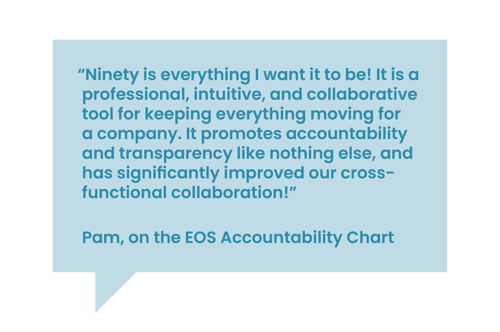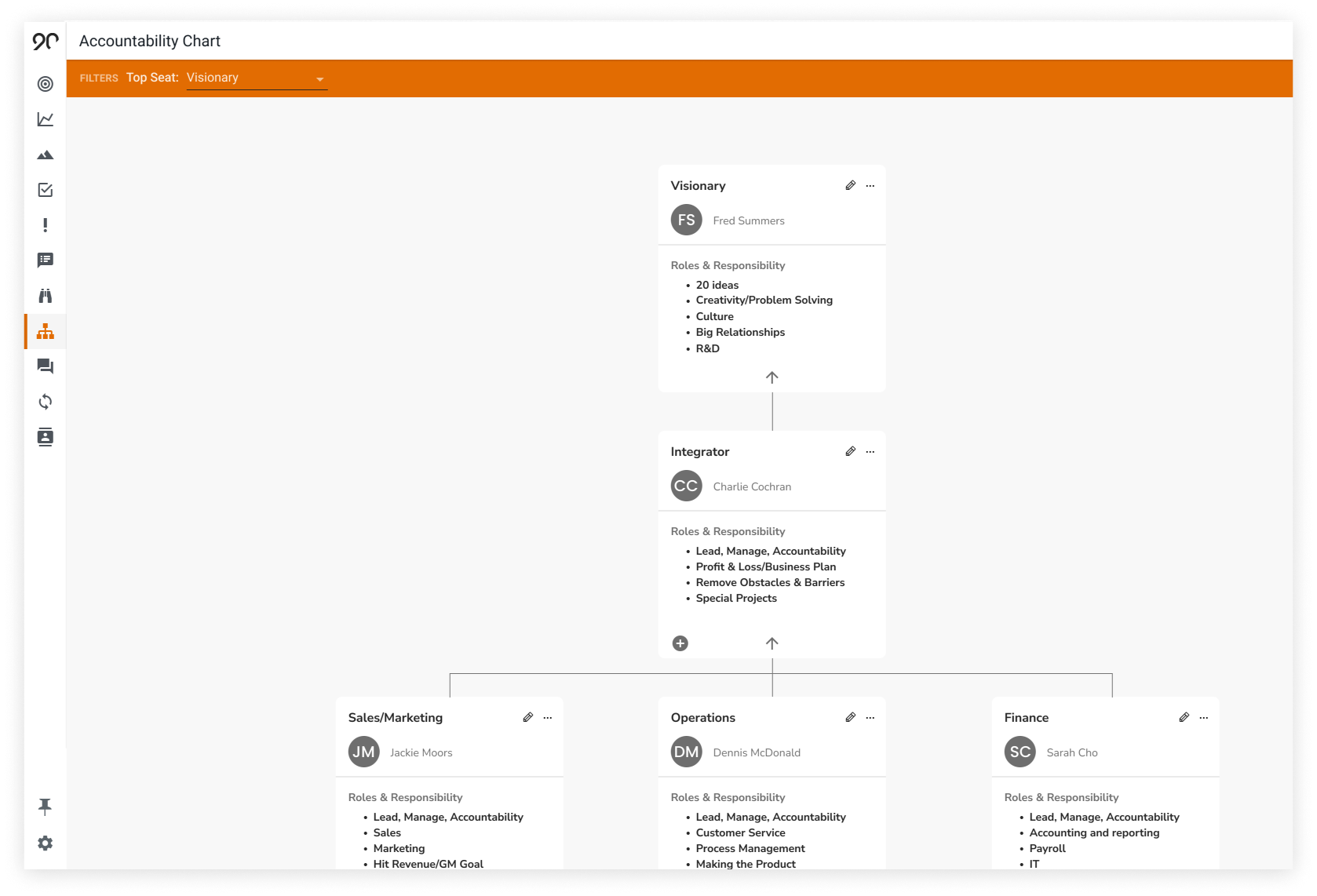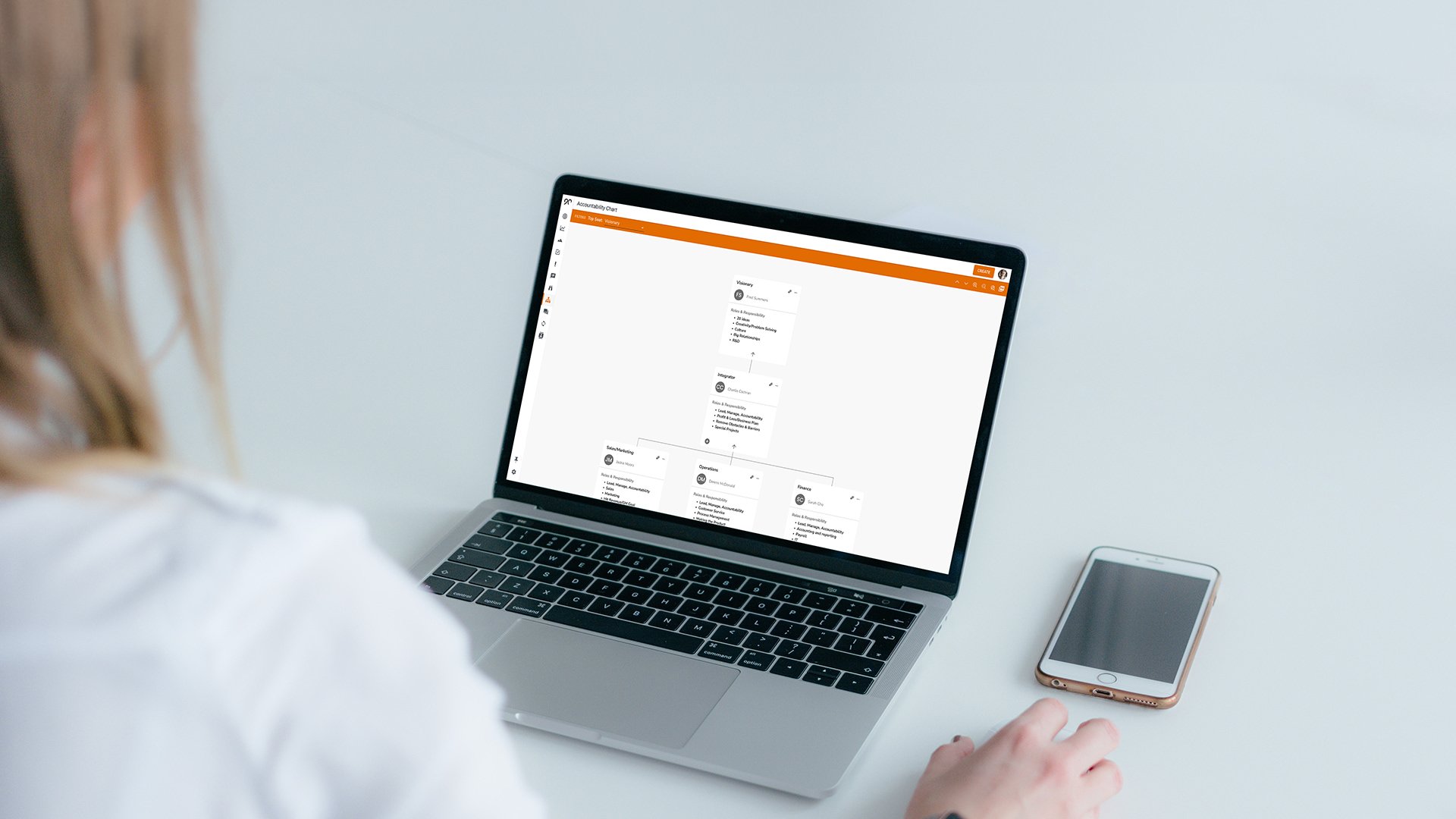EOS® Accountability Chart: Your Key to the Right People in the Right Seats
If you’re a business owner with more than 10 employees or an entrepreneur feeling stuck with defining clear roles and responsibilities within your organization, you can take solace in a simple truth: you're not alone. Many business leaders grapple with these issues, especially during periods of rapid growth or change.
What if there was a tool that could help you? A tool that’s easily scalable to account for new roles and also level-sets everyone in the organization regarding who does what?
The Accountability Chart™ is that tool. It’s a supercharged organizational chart that helps define and visualize the structure of an organization by focusing on functions and seats with roles and responsibilities instead of on titles and positions. There are no dotted lines or workarounds allowing seats to report to multiple leaders. And the chart doesn’t dictate who communicates with whom — we always want people to collaborate up and down the organization. When implemented as intended, the chart really lives up to its name: accountability.
Designed as part of the EOS Model®, The Accountability Chart is part of the People Component™ and has helped many entrepreneurs establish an organizational structure that puts the right people in the right seats.
My colleagues at Ninety are fond of saying, “Structure first, people second.” We build the right structure for the next 3, 6, and 12 months of operating our business. By design, we set aside 3 hours during a Focus Day® to work on The Accountability Chart. My longest session coached for this tool is 5 hours. We were having hard conversations with lots of emotion and some egos. When successful, you get to the place where leaders remove themselves from working “in” the business and will objectively work “on” the business to build the right structure.
This article will get you ready by highlighting:
- How to measure accountability in your business
- The importance of accountability and how it helps foster high-trust relationships
- How The Accountability Chart differs from an organizational chart
- Steps to creating an Accountability Chart and the benefits of doing so
Measuring Accountability in Your Business
EOS Implementers do a Help First session called the 90-Minute Meeting for those interested in learning more about EOS, the EOS Model, and its tools and implementation. I have delivered 100 of these, and I always ask this question: “What kind of accountability exists in your business? Rate it 1–10.”
Most of the responses I receive are between 3 and 5. Sometimes the leaders respond that their team is doing well — it's the rest of the organization that’s struggling. I call this a “mirror moment” because how the rest of the organization is going is a reflection of the senior leadership team. It starts at the top.
Building a company is a mix of art and science. The aforementioned rating isn’t important scientifically, but it is important that the senior leadership team is aligned with where they are at and how they’ll improve accountability. Most of the time, it’s a simple way of bringing clarity to what is expected from whom and when it is expected.
At Ninety, we refer to this as agreements-based leadership. We often have expectations of others, but we haven’t always been clear on our agreements. The Accountability Chart is a powerful way to bring clarity to these agreements by outlining roles and responsibilities, especially if a person is sitting in more than one seat.
After rolling out EOS to a company, we ask the entire team to participate in an Organizational Checkup®, which is another powerful EOS tool that allows us to measure our performance related to accountability as well as all Six Key Components®.

People: One of the Six Key Components of the EOS Model
The EOS Model organizes a holistic collection of concepts and tools that comprise a comprehensive business management system designed to help entrepreneurs get what they want from their businesses. It’s designed to align everyone around a vision, get everyone on the same page working toward the same goals, and provide the tools and processes needed to achieve them.
The Six Key Components are Vision, People, Data, Process, Issues, and Traction®. When talking about the EOS Accountability Chart, we’re obviously focusing on the People Component of the EOS Model, which anchors to the concept of placing the Right People in the Right Seats. This tool is designed to promote the very thing it’s named for: accountability.
There’s another benefit to structuring your organization with this tool, and that’s the invaluable opportunity to create high-trust relationships throughout the organization. The clarity of roles and responsibilities allows for agreements between people and teams, and those agreements build the kind of trust found in thriving organizations.
Once we have designed the seats and we have candidates for the seats, we use a tool called GWC®, or Get it, Want it, and Capacity to do it. Each team member answers these questions honestly such that we know if they are in the Right Seat.
Understanding the EOS Accountability Chart
At the very heart of an Accountability Chart is the representation of the necessary functions (fulfilled by people) needed to turn a founder’s vision into reality. This typically involves an Integrator working with department heads from Sales, Marketing, Human Resources, and so on to identify those functions and define their distinct roles and responsibilities. We often refer to these functions as “seats” for people to fill.
Early on, it’s not uncommon to find one person sitting in multiple seats until the organization grows and new people assume those particular roles and responsibilities.
There are five core disciplines to follow when establishing an Accountability Chart:
- Ensure core functions are grouped into three categories: Marketing/Sales, Operations, and Finance. All businesses, no matter how small, young, big, or old they are, have core functions in all these 3 categories. Also, all businesses have an Integrator function, and some businesses also may have a Visionary function.
- One person is responsible for each core function. As the saying goes, “When more than one person is responsible, no one is responsible.” That doesn’t suggest that the person responsible for sales does ALL the work for sales, of course. It’s just a thoughtful approach to help identify which roles and responsibilities need to be delegated to others to assist the person ultimately responsible for the function.
- Think functions, not titles. Which functions are needed to help move the vision even closer to reality? Get specific and outline about 5 roles and responsibilities for each function. For example, is a producer needed for project execution? Drilling down to the exact types of work each seat will be responsible for develops a better feel for potential capability and capacity issues.
- Structure first, people second. Don’t build your Accountability Chart based on your people or, even worse, titles. Allocate people to the seats later, when you genuinely understand the functions and their respective roles and responsibilities and can determine the skills and experience needed to succeed. Existing titles and chains of command frequently don’t align with what the future requires.
- Each team has one leader/manager. Each function that has one or more downstream sub-functions can only be occupied by one person. This is the equivalent of having no more than one leader/manager for each team or department. Also, these Seats must always include LMA™ (Leadership + Management = Accountability) as their first role and responsibility. Remember, no dotted lines.

Traditional Organizational Chart vs. EOS Accountability Chart
The five core disciplines we just outlined above essentially represent the differences between an Accountability Chart and a traditional organizational chart. The latter tends to be structured hierarchically (for example, Director, Senior Manager, Manager) and promotes the idea that growth within an organization only happens through an “ascension of the ranks.” It also comes with a fair amount of bloat in its chart, and that’s exactly the kind of excess that invariably leads to the dreaded “downsizing” or restructuring.
While an Accountability Chart also has hierarchy, it’s designed for the flow of accountability by focusing on functions, not titles. It also supports the idea of placing the Right Person in the Right Seat, a key distinction from traditional org charts and one that’s measured by ensuring someone understands the roles and responsibilities with the seat — and Gets it, Wants it, and has the Capacity to do it.
The Benefits of Implementing an EOS Accountability Chart
So, you might be asking, what are the other benefits of establishing an Accountability Chart beyond the great reasons already outlined? Let’s look at some:
1. It Enables Scalability through Company-Wide Visibility
Get insight into everyone’s function in the organization, their roles and responsibilities, and how they fit into the larger picture.
2. It Improves Communication
Team members can easily find and contact the right person(s) for interdepartmental answers and insight by looking up who is in the seat that has the answers.
3. It Enables Work Across Departments
Within Ninety, click on any role in the Accountability Chart to assign To-Dos or Issues to that person based on their expertise.
4. It Helps You Spot Capacity Issues and Fill Key Roles
Easily identify where you might need a new hire and how they could help the team and organization.
5. It Increases Transparency
Get insight into the goals team members are working toward, and how they connect with other team members' goals.
6. It Promotes Evolution
Company building is a “forever work,” so there will always be cycles up and down.
Step-by-Step Guide to Creating an Accountability Chart Powered by Ninety
The first step to take with the Accountability Chart is to organize the seats. Once the chart is organized, the seats can be edited as needed to add roles and responsibilities or update seat details. Here’s what that looks like at a high level:
Edit Existing Seats
- Click the profile icon to change who is assigned to the Seat.
- Click the pencil icon to edit the description of the Seat.
Add Seats to create new positions
- Click the plus icon under the card you wish for the new Seat to report to.
- Complete the information and click Create Seat.
- Assign someone to the new Seat by clicking the profile icon.
Move an Existing Seat to Rearrange the Chart or Add a New Manager
- Click the directional arrow button on the bottom-right of a Seat.
- Click which new Seat they should report to.
- Click Save to move the seat.
Get Greater Organizational Clarity and Efficiency
Don't let the complexities of defining roles and responsibilities hold your business back any longer.
With EOS Powered by Ninety and the EOS Toolbox™, you can visualize your organizational structure, assign clear roles and responsibilities, and track accountability in real-time.
It's more than just a tool — it's your partner in driving business success.






